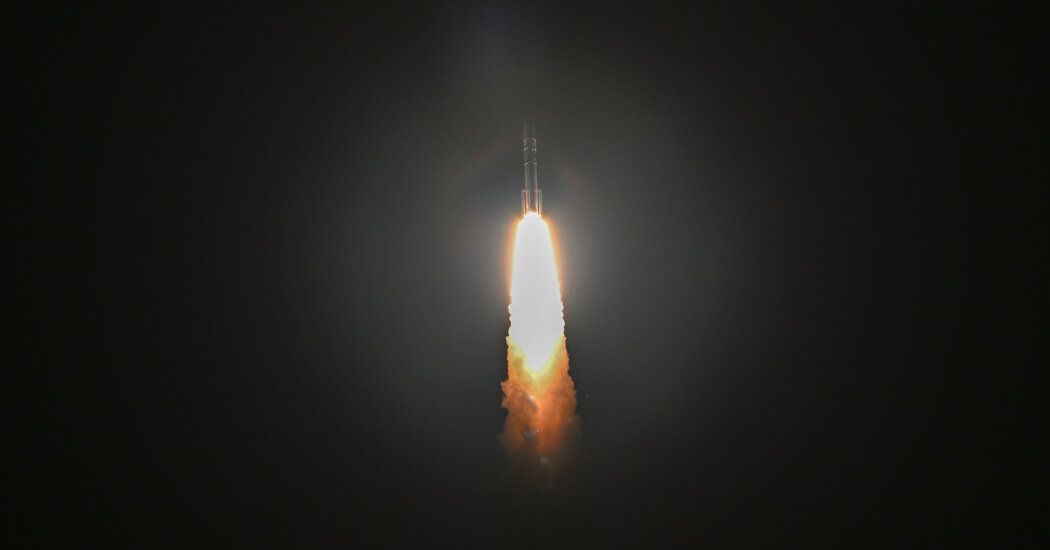A new rocket lifted off early Monday morning from Cape Canaveral, Florida, sending a robotic spacecraft toward the surface of the moon. No American spacecraft has made a soft landing on the Moon since 1972.
For United Launch Alliance, a joint venture between Boeing and Lockheed Martin, the successful launch of the Vulcan Centaur rocket was crucial. Vulcan is designed to replace two older rockets, and the US Space Force is also counting on it to launch spy satellites and other spacecraft that are important to US national security.
The Vulcan is also the first of several new rockets that could undermine the current dominance of the space launch market by Elon Musk’s company, SpaceX. SpaceX launched nearly 100 rockets into orbit last year. Other debut orbital launches in the coming months could include the Ariane 6 rocket from Arianespace, a European company, and New Glenn from Blue Origin, the company founded by Jeff Bezos, the founder of Amazon.
Overnight, the countdown to the Vulcan rocket launch went smoothly and the weather cooperated.
At 2:18 a.m. Eastern Time, the rocket’s engines ignited and it lifted off from the launch pad, heading east over the Atlantic Ocean.
“Everything seems fine,” United Launch Alliance launch commentator Rob Gannon said repeatedly as the Vulcan headed into space.
“Yes, yes,” said Tory Bruno, the company’s chief executive, after the lunar spacecraft’s deployment. “I am very excited. “I can’t tell you how much.”
United Launch Alliance was formed in 2006 and for seven years was the only company certified by the United States government to send national security payloads to orbit. So far it has used two vehicles: the Delta IV, developed by Boeing, which will complete its final flight at the end of this year, and the Atlas V, developed by Lockheed Martin, which will also retire within a few years.
There are 17 Atlas V launches left, but the rocket uses Russian-made engines, which became more politically untenable with rising tensions between Russia and the United States. That led ULA to begin development of the Vulcan, which replaces the capabilities of both rockets at a lower cost, United Launch Alliance officials said.
“What’s unique about Vulcan, and what we originally set out to do, was to provide a rocket that has all the capabilities of Atlas and Delta in a single system,” said Mark Peller, ULA vice president in charge of Vulcan development. “Because we have that adjustability, your configuration can really be tailored to the specific mission.”
Vulcan can be configured in several ways. Its core booster stage, the main body of the rocket, is powered by two BE-4 engines manufactured by Blue Origin. The engines, which emit deep blue flames when burning methane fuel, will also be used on Blue Origin’s New Glenn rocket.
Up to six solid rocket boosters can be attached to the side of the core to increase the amount of mass it can put into orbit. Its nose cone comes in two dimensions: a standard 51-foot-long size and a longer 70-foot size for larger payloads.
“The launch market is stronger than it has been in decades,” said Carissa Christensen, CEO of Bryce Tech, a consulting firm in Alexandria, Virginia. “And anticipated demand is likely enough to support multiple launch providers, including Vulcano.”
ULA already has a portfolio of more than 70 missions to fly on Vulcan. Amazon purchased 38 launches for deployment on Project Kuiper, a constellation of communications satellites that will compete with SpaceX’s Starlink network to provide high-speed satellite Internet.
Many of the other launches will be for the Space Force. ULA and SpaceX are currently the only companies approved to launch national security missions. Monday’s launch is the first of two demonstration missions the Space Force requires to gain confidence in Vulcan before using the launcher for military and surveillance payloads.
The second launch is to lift Dream Chaser, an unmanned space plane built by Sierra Space of Louisville, Colorado, on a cargo delivery mission to the International Space Station. Four additional Vulcan launches could then follow this year for the Space Force.
The primary payload for Vulcan’s first launch was Peregrine, a spacecraft built by Astrobotic Technology of Pittsburgh. Astrobotic, founded in 2007, is one of several private companies that aim to offer a delivery service to the surface of the moon. Its main client for this trip is NASA, which paid Astrobotic $108 million to carry out five experiments. This is part of the scientific work carried out by the space agency to prepare the return of astronauts to the Moon within the framework of the Artemis program.
Unlike in the past, when NASA built and operated its own spacecraft, this time it relies on companies like Astrobotic to provide transportation.
A second burn of the Vulcan’s second stage engine that lasted about four minutes sent Peregrine on its way to the moon. “It’s a dream,” John Thornton, CEO of Astrobotic, said on NASA’s television broadcast after the launch. “We are on our way to the moon.”
About 50 minutes after launch, the Astrobotic spacecraft separated from the rocket.
After a trip to the Moon that will last two and a half weeks, the Peregrine lander will enter orbit around the Moon and orbit there until February 23, when it will attempt to land on Sinus Viscositatis (Latin for “Bay of Stickiness “), an enigmatic region on the visible side of the Moon.
Vulcan also lifted a secondary payload for Celestis, a company that commemorates people by sending some of their ashes or DNA into space. Two toolbox-sized containers attached to the Vulcan’s upper stage house small cylindrical capsules.
Among the people whose remains are found on this final voyage are Gene Roddenberry, the creator of Star Trek; his wife, Majel Barrett, who played Nurse Chapel on the original television show; and three other actors from the show: DeForest Kelley, who played doctor Leonard “Bones” McCoy; Nichelle Nichols, who played Uhura, the communications officer; and James Doohan, who played Montgomery Scott, the chief engineer.
One of the capsules contains hair samples from three American presidents: George Washington, Dwight Eisenhower and John F. Kennedy.
A brief final engine burn sent the second stage and the Celestis monument into orbit around the sun.
Celestis, as well as another company offering similar services, San Francisco’s Elysium Space, also has a payload on Peregrine. This has sparked an outcry from Navajo Nation leaders, who say many Native Americans consider the moon a sacred place and that sending human remains there is a desecration. Navajo officials asked the White House to delay the launch to discuss the matter.
Charles Chafer, CEO of Celestis, said he respected everyone’s religious beliefs, but “I don’t believe you can regulate space missions based on religious reasons.”
During press conferences, NASA officials noted that they were not in charge of the mission and had no direct say over other payloads that Astrobotic sold on Peregrine. “An intergovernmental meeting is being organized with the Navajo Nation that NASA will support,” Joel Kearns, NASA’s deputy associate administrator for exploration, said during a press conference Thursday.
John Thornton, Astrobotic’s chief executive, said Friday that he was disappointed that “this conversation came up so late” because his company had announced Celestis and Elysium’s involvement years ago.
“We’re really trying to do the right thing,” Thornton said. “I hope we can find a good path forward with the Navajo Nation.”
NASA announced the program to tap private industry for deliveries to the moon, called Commercial Lunar Cargo Services, or CLPS for short, in 2018. But it has been slow to get off the ground. After repeated delays, Astrobotic’s Peregrine flight is the first CLPS mission to reach space and will reach lunar orbit first. But it may not be the first to land.
A second CLPS mission, from Intuitive Machines of Houston, is scheduled to launch in mid-February and will take a faster path to the moon, meaning it could reach the surface before Peregrine.
While Vulcan has many payloads to launch in the coming years, its long-term prospects are less clear. Other aerospace companies are looking to win some of Space Force’s business, and Amazon could in the future move many more of its Kuiper launches to Bezos’ Blue Origin.
Another factor affecting Vulcan’s future is that SpaceX lands and reuses its Falcon 9 boosters, which will likely give it a considerable price advantage over ULA. In contrast, the entire Vulcan rocket is used only once. Blue Origin also plans to reuse the New Glenn thrusters.
ULA is developing technology that could be used to recover the two booster motors, the most expensive part of the rocket, but that is years away.










